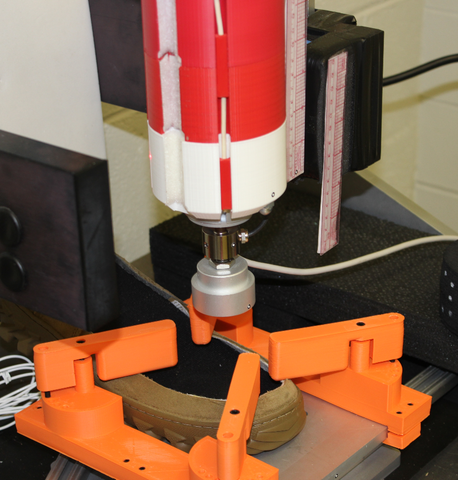Taking Measure
Just a Standard Blog

Perhaps for as many as 40,000 years, people have been protecting their feet with some type of covering, initially using animal hides and fur. Today, footwear has become high-tech, sophisticated, and in some cases smart, incorporating sensors that communicate with apps on your phone. Much of the advancement in footwear is possible because of standards that address the basic performance and functionality, allowing manufacturers to go beyond the basics.
There are hundreds of standards for all types of shoes, from industrial work boots to high-heeled dress shoes and everything in between, and for the shoe materials and components. Most of these are published by private-sector standards-developing organizations, such as SATRA, ISO and ASTM International. But what do I care if my shoes meet any standards? I just want them to look good, feel good and be fit for my activity — running shoes for jogging, boots for hiking, high heels for dancing, safety shoes for work — that’s all there is to it, right? Not quite. In terms of construction, fit, comfort, functionality and protection, footwear is probably the most complex of all the clothing that we wear.
While some aspects of footwear are simply cosmetic, such as the style and color, there are performance and protection aspects to consider. For instance, how do I know my running shoes will protect my feet and ankles over miles of pavement? Will my hiking boot support my ankle if I step on a tree root? Will a nail go through the sole of my safety shoe? What keeps the heels from breaking off of my dancing shoes? The answer to all of these questions is: standards.
While issues like those listed above are important to everyone, they are critical for soldiers in the field, who can literally be taken out of action due to foot or ankle injuries. For each geographic region in the world, the U.S. Army issues soldiers appropriate footwear for the environment and writes a “purchase description” that specifies the requirements for that footwear in detail. Historically, those purchase descriptions have had many design and material requirements.
For instance, jungle combat boots are intended for a hot, humid, wet jungle climate. I’ve listed some paraphrased examples of the Army’s requirements below:
- The uppers must be leather and nylon, each meeting other military standards.
- The outsoles must be rubber with a specified tread pattern for gripping in mud, and the midsole must be pure polyether polyurethane.
- The boot is supposed to shed water and dry quickly, with a specific requirement to have drainage holes in the sides.
- Puncture-resistant material must be used in the insoles to protect against punji sticks (booby traps made of sharpened stakes) or other sharp objects that may be stepped on in jungles.
All these design and material requirements cannot be changed without a lengthy approval process by the Army. To improve its purchase descriptions, the Army asked the National Institute of Standards and Technology (NIST) to help it transition from detailed material and design requirements to more general performance requirements. For example, instead of specifying leather, a better option would be to specify performance requirements and test methods related to durability and strength. This would allow new materials to be used, such as microfibers and hybrid composites. Specifying performance requirements is more challenging, but it allows for innovation and use of new technologies, which will likely result in improved protection, performance and comfort for soldiers.
NIST, working with the Army, other federal agencies and private-sector stakeholders, delivered a roadmap detailing 13 recommendations to make the transition to specifying performance requirements for jungle combat boots. The recommendations we made were related to biomechanics and injury reduction, comfort and durability.
For biomechanics and injury reduction, we found that the greatest benefit could be achieved by defining requirements and a test method for ankle support. This would be hugely beneficial across the footwear industry, affecting not just military boots, but also hiking boots, work boots and ice skates. The manufacturers of these types of footwear claim that their products provide ankle support, but there is currently no standardized test for verifying the claims. The Army is taking steps to implement this recommendation, and NIST is working with them to develop a standardized ankle support test method.
For comfort, we recommended that the material properties of the currently used leather and nylon be made a baseline in order to set performance requirements, allowing new materials that meet those requirements to be used. For boot construction, the highest impact items are related to keeping the sole attached to the upper, and that involves improving existing test methods or developing new methods. All the recommendations we made for jungle combat boots are relevant for most types of military footwear, and we expect their implementation will be beneficial to all the armed services.
To inform the recommendations in the roadmap, we did preliminary testing on the Army-issued jungle combat boots, popular commercially made combat boots and a running shoe. We explored the following attributes: impact attenuation (the ability of footwear to lessen the effect of impact on the body), puncture resistance of the sole, and water absorption and drainage.

Impact attenuation is typically evaluated by repeatedly dropping an impactor onto a designated location in either the heel or toe of the sole. The forces produced by the impact and the deformation of the sole are recorded. These responses can be compared among boot models to understand which boots will generally produce the lowest forces on the wearer's feet.
Puncture resistance is typically assessed by driving a standard pin through the sole to determine how well it can resist penetration from sharp objects. The standard test is performed at a slow rate, but we considered both the standard rate and much faster rates, including one that represents a wearer who has jumped down from a height of about a half meter. The purpose of varying the puncture rate was to determine if the protection provided by the soles and puncture-resistant layers would change during faster rate punctures.
For water absorption and drainage, we designed tests to mimic many common situations in which footwear might get wet, such as stepping in a puddle, and monitored the time required for the shoe to drain water and fully dry. These tests are important for any type of footwear that might be used in a wet environment, such as a running or hiking boot. Keeping the foot as dry as possible is important for both user comfort (no one likes squishy wet socks!) and foot health (to prevent fungal infections and annoyances like blisters).
As you can see, NIST is doing its part to advance technology, to improve standards, and to help the Army improve soldier footwear. And, by the way, this work may lead to better shoes for you.
I’d like to thank my collaborators, Amanda Forster and Mike Riley, for their invaluable help in performing research and developing recommendations that will lead to improved footwear test methods.
About the author
Related Posts
Comments
The article is titled, "A Step in the Right Direction: Building a Better Army Boot," but the people in the graphic are wearing Air Force uniforms. The Army and Air Force boots are not interchangeable with this uniform configuration.






Amazing invention that links modern technology with boots! This will save time, improves productivity due to controlable comfort and increases the age of shoes/boot.